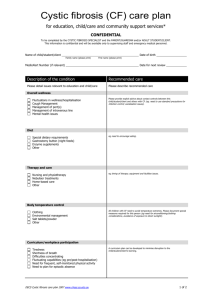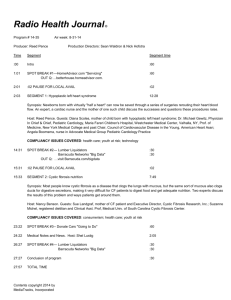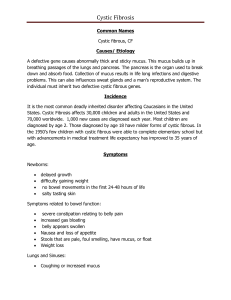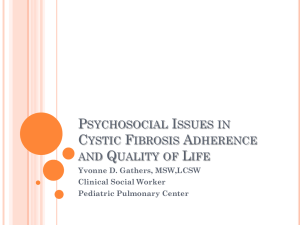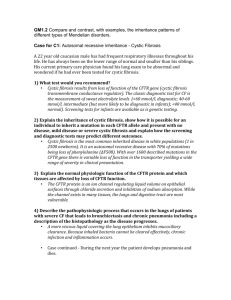Cystic Fibrosis
advertisement
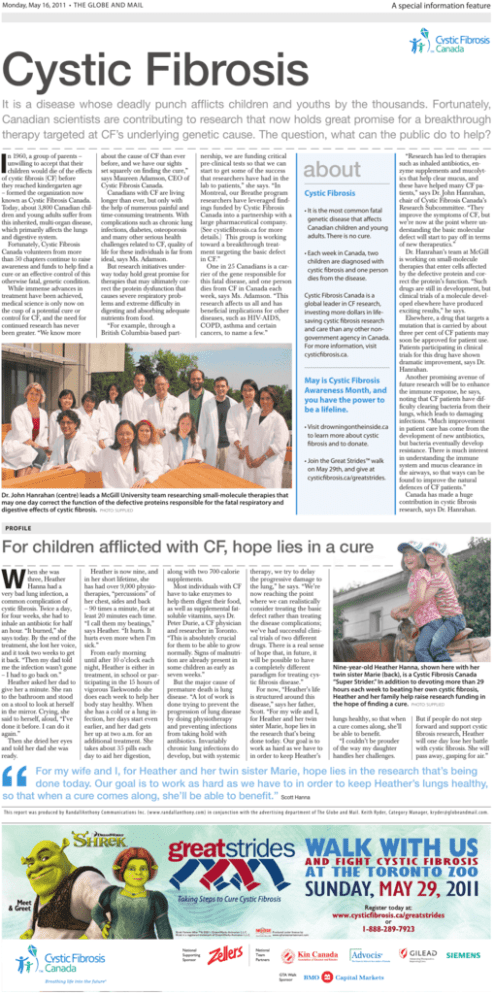
Monday, May 16, 2011 • THE GLOBE AND MAIL A special information feature Cystic Fibrosis It is a disease whose deadly punch afflicts children and youths by the thousands. Fortunately, Canadian scientists are contributing to research that now holds great promise for a breakthrough therapy targeted at CF’s underlying genetic cause. The question, what can the public do to help? I n 1960, a group of parents – unwilling to accept that their children would die of the effects of cystic fibrosis (CF) before they reached kindergarten age – formed the organization now known as Cystic Fibrosis Canada. Today, about 3,800 Canadian children and young adults suffer from this inherited, multi-organ disease, which primarily affects the lungs and digestive system. Fortunately, Cystic Fibrosis Canada volunteers from more than 50 chapters continue to raise awareness and funds to help find a cure or an effective control of this otherwise fatal, genetic condition. While immense advances in treatment have been achieved, medical science is only now on the cusp of a potential cure or control for CF, and the need for continued research has never been greater. “We know more about the cause of CF than ever before, and we have our sights set squarely on finding the cure,” says Maureen Adamson, CEO of Cystic Fibrosis Canada. Canadians with CF are living longer than ever, but only with the help of numerous painful and time-consuming treatments. With complications such as chronic lung infections, diabetes, osteoporosis and many other serious health challenges related to CF, quality of life for these individuals is far from ideal, says Ms. Adamson. But research initiatives underway today hold great promise for therapies that may ultimately correct the protein dysfunction that causes severe respiratory problems and extreme difficulty in digesting and absorbing adequate nutrients from food. “For example, through a British Columbia-based part- nership, we are funding critical pre-clinical tests so that we can start to get some of the success that researchers have had in the lab to patients,” she says. “In Montreal, our Breathe program researchers have leveraged findings funded by Cystic Fibrosis Canada into a partnership with a large pharmaceutical company. (See cysticfibrosis.ca for more details.) This group is working toward a breakthrough treatment targeting the basic defect in CF.” One in 25 Canadians is a carrier of the gene responsible for this fatal disease, and one person dies from CF in Canada each week, says Ms. Adamson. “This research affects us all and has beneficial implications for other diseases, such as HIV-AIDS, COPD, asthma and certain cancers, to name a few.” about Cystic Fibrosis • It is the most common fatal genetic disease that affects Canadian children and young adults. There is no cure. • Each week in Canada, two children are diagnosed with cystic fibrosis and one person dies from the disease. Cystic Fibrosis Canada is a global leader in CF research, investing more dollars in lifesaving cystic fibrosis research and care than any other nongovernment agency in Canada. For more information, visit cysticfibrosis.ca. May is Cystic Fibrosis Awareness Month, and you have the power to be a lifeline. • Visit drowningontheinside.ca to learn more about cystic fibrosis and to donate. • Join the Great Strides™ walk on May 29th, and give at cysticfibrosis.ca/greatstrides. Dr. John Hanrahan (centre) leads a McGill University team researching small-molecule therapies that may one day correct the function of the defective proteins responsible for the fatal respiratory and digestive effects of cystic fibrosis. PHOTO: SUPPLIED “Research has led to therapies such as inhaled antibiotics, enzyme supplements and mucolytics that help clear mucus, and these have helped many CF patients,” says Dr. John Hanrahan, chair of Cystic Fibrosis Canada’s Research Subcommittee. “They improve the symptoms of CF, but we’re now at the point where understanding the basic molecular defect will start to pay off in terms of new therapeutics.” Dr. Hanrahan’s team at McGill is working on small-molecule therapies that enter cells affected by the defective protein and correct the protein’s function. “Such drugs are still in development, but clinical trials of a molecule developed elsewhere have produced exciting results,” he says. Elsewhere, a drug that targets a mutation that is carried by about three per cent of CF patients may soon be approved for patient use. Patients participating in clinical trials for this drug have shown dramatic improvement, says Dr. Hanrahan. Another promising avenue of future research will be to enhance the immune response, he says, noting that CF patients have difficulty clearing bacteria from their lungs, which leads to damaging infections. “Much improvement in patient care has come from the development of new antibiotics, but bacteria eventually develop resistance. There is much interest in understanding the immune system and mucus clearance in the airways, so that ways can be found to improve the natural defences of CF patients.” Canada has made a huge contribution in cystic fibrosis research, says Dr. Hanrahan. PROFILE For children afflicted with CF, hope lies in a cure W hen she was three, Heather Hanna had a very bad lung infection, a common complication of cystic fibrosis. Twice a day, for four weeks, she had to inhale an antibiotic for half an hour. “It burned,” she says today. By the end of the treatment, she lost her voice, and it took two weeks to get it back. “Then my dad told me the infection wasn’t gone – I had to go back on.” Heather asked her dad to give her a minute. She ran to the bathroom and stood on a stool to look at herself in the mirror. Crying, she said to herself, aloud, “I’ve done it before. I can do it again.” Then she dried her eyes and told her dad she was ready. “ Heather is now nine, and in her short lifetime, she has had over 9,000 physiotherapies, “percussions” of her chest, sides and back – 90 times a minute, for at least 20 minutes each time. “I call them my beatings,” says Heather. “It hurts. It hurts even more when I’m sick.” From early morning until after 10 o’clock each night, Heather is either in treatment, in school or participating in the 15 hours of vigorous Taekwondo she does each week to help her body stay healthy. When she has a cold or a lung infection, her days start even earlier, and her dad gets her up at two a.m. for an additional treatment. She takes about 35 pills each day to aid her digestion, along with two 700-calorie supplements. Most individuals with CF have to take enzymes to help them digest their food, as well as supplemental fatsoluble vitamins, says Dr. Peter Durie, a CF physician and researcher in Toronto. “This is absolutely crucial for them to be able to grow normally. Signs of malnutrition are already present in some children as early as seven weeks.” But the major cause of premature death is lung disease. “A lot of work is done trying to prevent the progression of lung disease by doing physiotherapy and preventing infections from taking hold with antibiotics. Invariably chronic lung infections do develop, but with systemic therapy, we try to delay the progressive damage to the lung,” he says. “We’re now reaching the point where we can realistically consider treating the basic defect rather than treating the disease complications; we’ve had successful clinical trials of two different drugs. There is a real sense of hope that, in future, it will be possible to have a completely different paradigm for treating cystic fibrosis disease.” For now, “Heather’s life is structured around this disease,” says her father, Scott. “For my wife and I, for Heather and her twin sister Marie, hope lies in the research that’s being done today. Our goal is to work as hard as we have to in order to keep Heather’s Nine-year-old Heather Hanna, shown here with her twin sister Marie (back), is a Cystic Fibrosis Canada “Super Strider.” In addition to devoting more than 29 hours each week to beating her own cystic fibrosis, Heather and her family help raise research funding in the hope of finding a cure. PHOTO: SUPPLIED lungs healthy, so that when a cure comes along, she’ll be able to benefit. “I couldn’t be prouder of the way my daughter handles her challenges. But if people do not step forward and support cystic fibrosis research, Heather will one day lose her battle with cystic fibrosis. She will pass away, gasping for air.” For my wife and I, for Heather and her twin sister Marie, hope lies in the research that’s being done today. Our goal is to work as hard as we have to in order to keep Heather’s lungs healthy, so that when a cure comes along, she’ll be able to benefit.” Scott Hanna This repor t was produced by RandallAnthony Communications Inc. (w w w.randallanthony.com) in conjunc tion with the adver tising depar tment of The Globe and Mail. Keith Ryder, Categor y Manager, kr yder@globeandmail.com.
